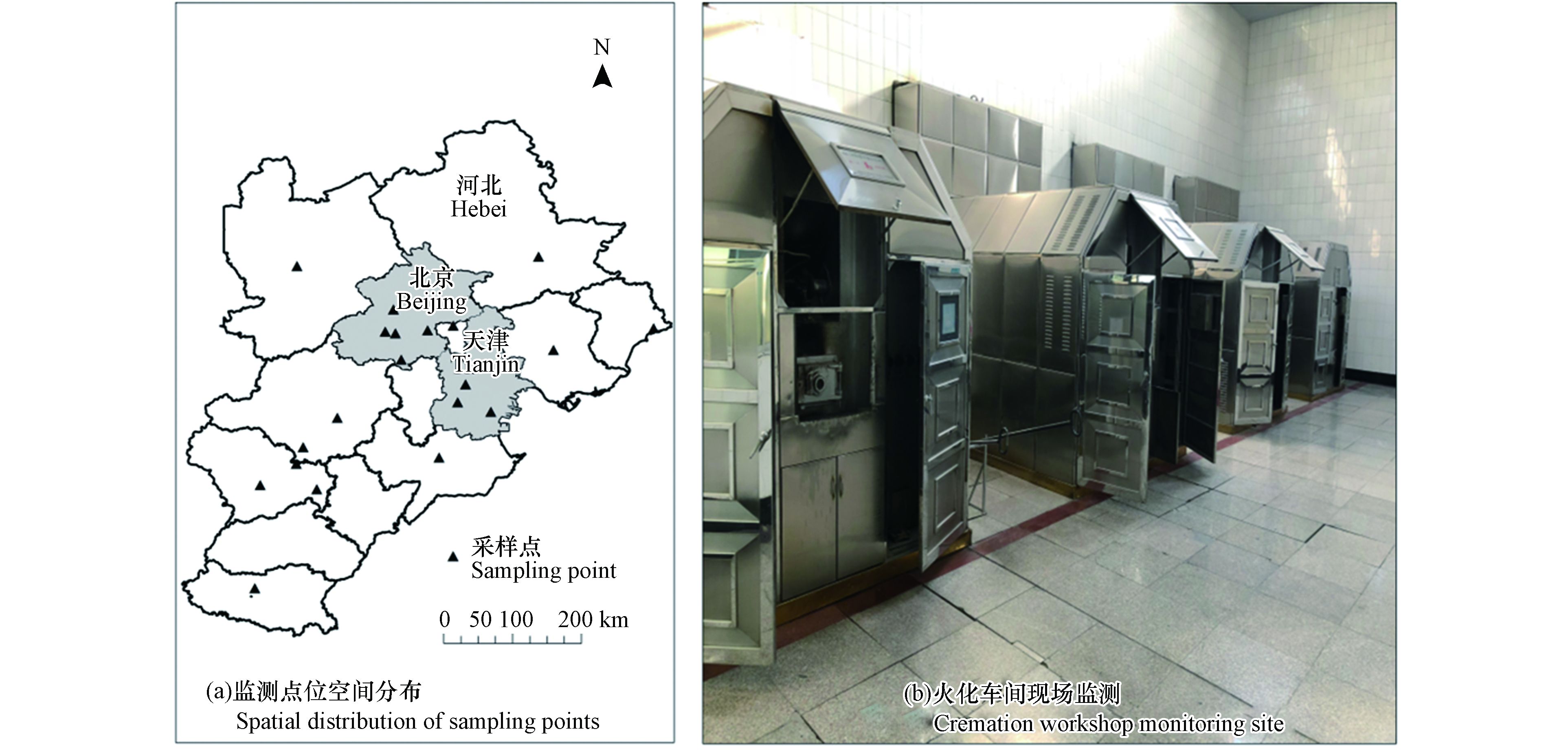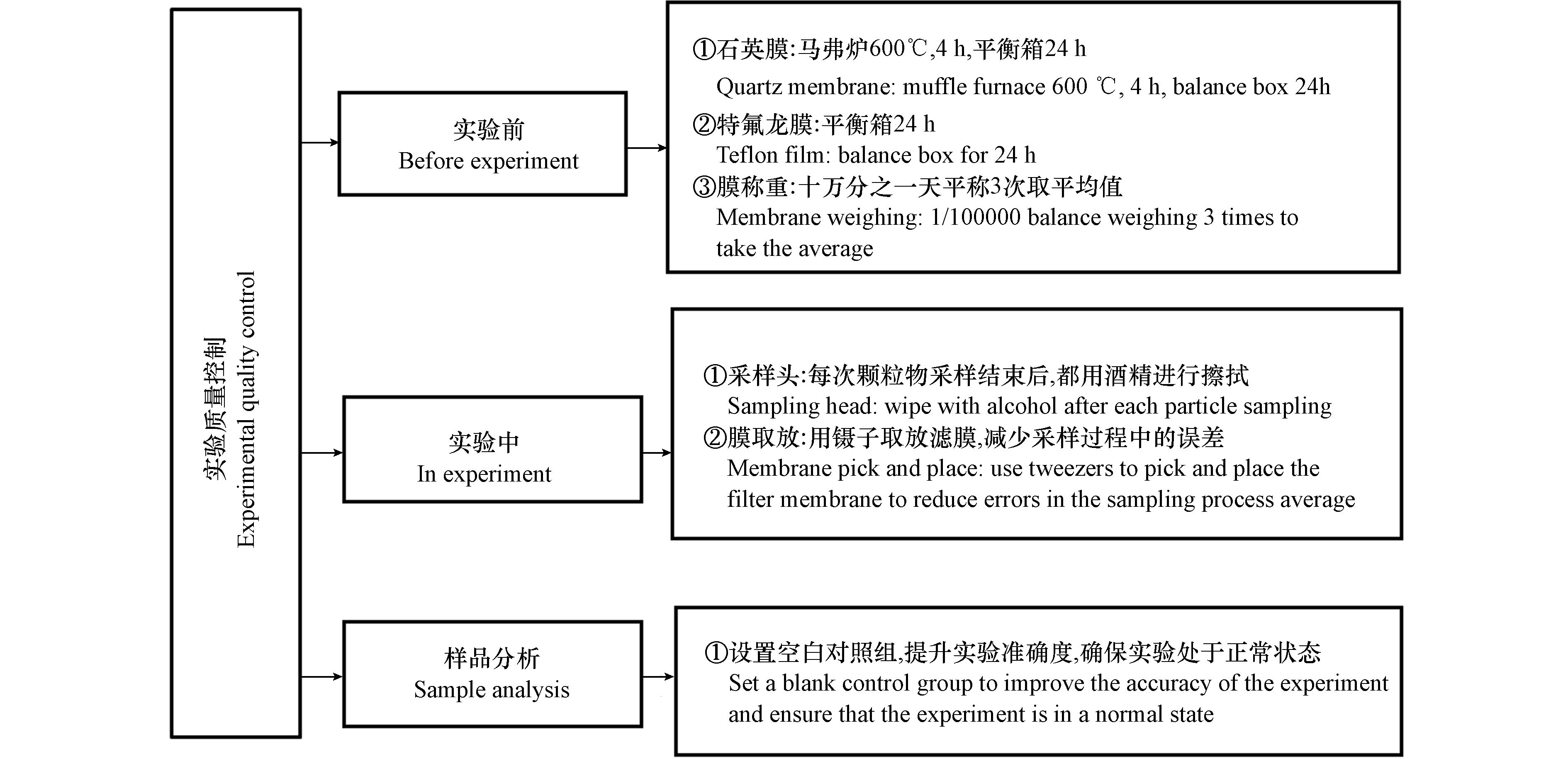-
火化和遗物祭品焚烧的过程中会排放颗粒物、SO2、NOX、二噁英等污染物,是一类大气污染源,与其他工业行业相比,污染控制程度较低,对周边空气质量及人体健康的影响问题逐渐引起关注[1-6]。随着国家和地方《火葬场大气污染物排放标准》发布和实施,火化机和遗物祭品焚烧污染排放得到了一定的控制,火葬场环境空气污染物水平有所下降[7-11]。但火化车间受工作负荷、设备密闭性、操作规范等因素的影响较大,车间内颗粒物浓度较高,现场气味较大,车间内工作人员由于长期暴露,会对人体造成一定健康影响[12-15]。定量和识别火化车间PM2.5排放水平及重金属呼吸暴露风险评估,对于研究制定相应的防治措施具有重要的作用。
目前,一些学者已对多个行业领域开展了暴露风险评价研究,例如化工石油、垃圾焚烧、机动车尾气等[16-18],研究的污染物包括颗粒物、二噁英、挥发性有机物等,而对火葬场的研究还主要集中在排放特征和控制对策上,例如薛亦峰等[19-21]通过实地调研和资料收集,获取了北京市火葬场实际活动水平,更新排放清单并模拟其对周边环境的影响,还对中国火葬场有害空气污染物排放现状及未来发展趋势进行了预测;张世豪等[22-23]通过现场调研与问卷调查,补充和更新了全国遗物祭品焚烧量,并通过对标国家和地方标准,研究了遗物祭品焚烧污染排放特征,结合行业特点提出了控制对策;刘杰等[24]通过对火葬场场所的PM2.5和VOCs进行现场采集,识别了浓度和组分特征,基于大气环境质量改善目标,提出了相应控制对策;Cui等[25]则通过与其他行业对比,重点分析了火葬场所臭气浓度水平,结合设备运行维护和人员操作水平,提出减排期间及控制对策结合设备运行维护和车间通风换气设施条件等,分析了行业未来的减排潜力。为填补领域研究空白,开展火化车间PM2.5排放特征及暴露风险评价研究十分必要。
研究对京津冀区域内20家火葬场的火化车间PM2.5进行样品采集,分析其PM2.5浓度水平和组分特征,通过EPA推荐的暴露风险评价方法,开展火化车间PM2.5中的重金属元素对人体的暴露风险评估,探明对人体健康影响的大小,并提出了相应的控制对策。以期为开展火葬场大气污染物管理和控制和保证一线工作人员身体健康提供参考和支撑。
-
京津冀地区共有181家火葬场,其中北京市12家、天津市11家、河北省158家,2019年京津冀火化量达39.2万具[26],其中北京和天津由于政策鼓励,火化量逐年上升,而河北省推进殡葬改革,积极尝试殡葬新方式,火化量有所减少。本研究在对研究区域火葬场基础信息调研的基础上,综合其火化量、烟气净化系统安装情况及地区经济发展水平等因素,选择了20家典型火葬场,于2018—2020年间对火化车间进行PM2.5采样采集,其中2018年11家、2019年4家、2020年5家,采样时间为每年7—10月,采样点空间分布及监测现场如图1所示。
火化车间内一般有数台火化机,其自动化或燃烧条件较差,在运行过程中要通过能开合的观察孔查看炉内燃烧状况,开孔易造成烟气逸散,使得火化车间内气味较重,加上扩散条件较差,车间内颗粒物浓度较高,排放水平也与设备的运行管理和人员操作水平有关。
-
采用PM10/PM2.5双级虚拟撞击采样器(青岛恒远)进行现场采样,设置采样时长为45—60 min。采样后利用离子色谱分析仪(IC,Dionex 600,USA)分析PM2.5样品中的无机水溶性离子。金属元素浓度利用电感耦合等离子体-原子发射光谱仪(ICP-AES,SPECTRO Analytical Instruments GmbH,SPECTRO ARCOS EOP)进行分析,采样集分析方法如表1所示。
为确保样品和实验数据的可靠性,对实验质量进行严格把控。采样前对采样膜进行处理,以去除易造成误差的干扰性因素。石英膜需在采样前使用马弗炉进行4 h灼烧,温度需达到600℃,然后在恒温箱中平衡24 h。为减少称量误差,用十万分之一天平反复称重滤膜3次取平均值;特氟龙膜采用同样的方式进行平衡称重。在采样时严格按照采样器要求进行操作,每次颗粒物采样结束后,都用酒精对采样器的切割头进行擦拭,用镊子取放滤膜,减少采样过程中的误差。在组分分析时,每组都要做相应的空白实验,如图2所示。
-
采用美国环境保护署(U.S. Environmental Protection Agency, USEPA)推荐的暴露模型进行评价,USEPA将化学物分为致癌与非致癌物质,并对其风险值进行计算[27-28]。
非致癌风险评价通过比较特定时间段内的暴露水平与暴露期参考剂量(Reference Dose, RfD)来评估其风险水平。非致癌风险的危险商(Hazard Quotient, HQ)的计算公式如下。当HQ>1时,表示元素对人体有非致癌风险且不可接受,并且风险可能会随着HQ值的增加而增加;当HQ≤1时,则表示在可接受范围内。
式中,RfD指参考剂量,通常低于RfD的暴露剂量不产生暴露风险,单位为mg·(kg·d)−1;ADD表示致癌元素寿命平均日剂量,mg·(kg·d)−1。
致癌风险用来估计个体接触潜在致癌物而患癌症的递增概率。终生癌症风险增量(Incremental Lifetime Cancer risk, ILCR)是指致癌物引起的个体年平均患癌症的风险。对于致癌物量,当ILCR<10−6时,金属元素致癌风险极小;当ILCR在1×10−6至1×10−4之间时,表示致癌风险相对可接受;当ILCR大于1×10−4时,表示该致癌风险不可接受。ILCR计算公式如下:
式中,SF指斜率因子,单位为(kg·d)·mg−1;ADD指致癌元素寿命平均日剂量,mg·(kg·d)−1,计算公式如下:
式中,c代表污染物浓度,mg·m−3;IR指呼吸频率,m3·d−1;EF代表暴露频率,d·a−1;ED指暴露持续时间a;BW指体重,kg;AT指平均暴露时间,d。
EPA提供的RfD及EF取值如表2所示。
-
由于火化车间内临时人员暴露时间较短,不足以产生致癌和非致癌风险,因此主要对从业人员暴露风险参数进行调查。采用现场调查的方式,在火化车间PM2.5采样的同时,对车间内从业人员的体重、呼吸频率及车间暴露时间等关键参数进行现场调查和了解,并询问其有无个人及家族遗传病史等情况,以排除除火化车间暴露外其他外在因素导致的致癌和非致癌风险。根据调查结果对持续暴露时间及暴露因子等进行了本地化确定,如表3所示。
-
根据火化车间PM2.5采样分析,得到PM2.5浓度范围(见图3a)。由于火化车间PM2.5浓度水平受室内通风及布局、设备数量及气密性、操作规范等多种因素的影响,使得PM2.5浓度波动范围较大,浓度范围为87—2765 μg·m−3,平均浓度为470 μg·m−3,约为《国家环境空气质量标准》二级浓度(GB 3095—2012,24 h平均限值75 μg·m−3)的6.3倍,会严重危害人体健康。由于不同车间内火化机数量不同,其工作负荷差异较大,且由于监测时段不同,导致监测结果浓度差异较大。
考虑到采样当天PM2.5背景值对测试结果有一定干扰,调取了采样当天各地的PM2.5背景浓度水平(全国城市空气质量实时发布平台,https://air.cnemc.cn:18007/),对扣除PM2.5背景浓度水平的火化车间PM2.5浓度水平进行了分析(见图3b),扣除背景值后火化车间PM2.5浓度范围为50—2693 μg·m−3,平均浓度为410 μg·m−3,相比扣除背景值前仅下降了12.7%。因此,背景浓度对火化车间PM2.5浓度影响较小,扣除背景值后其平均浓度仍较环境空气质量标准高出数倍。
-
颗粒物中的金属元素大部分具有难降解和易吸附的特性,可对人体器官造成功能性障碍,引发不可逆性损伤[30-32],水溶性离子具有吸湿性和溶解性,是污染源解析的重要参考依据[33-35]。对火化车间PM2.5中水溶性离子的分析结果显示(见图4a),8种水溶性离子的平均总质量浓度为26.9 μg·m−3,占车间PM2.5平均浓度的4.5%。其中Ca2+、NO3−、SO42−和NH4+是火化车间PM2.5的主要离子成分,质量浓度分别为7.3、5、4.1 、4.1 μg·m−3,分别占离子总浓度的27.1%、18.4%、15.4%和15.3%,而Cl−、K+、Na+和Mg2+则占比较小。对火化车间PM2.5中重金属元素的分析结果显示(见图4b),重金属元素总质量浓度为131.2 μg·m−3,占车间PM2.5平均浓度的22%。其中Ca和Al是主要的重金属元素,平均质量浓度分别为47 μg·m−3和24.8 μg·m−3,分别占重金属元素总浓度的35.8%和18.9%。
-
采用EPA推荐的暴露风险评价模型,基于实际调查获取的暴露风险参数,对火化车间PM2.5重金属暴露风险进行评价。总的来说,火化车间PM2.5中重金属对暴露人群的非致癌和致癌风险在可接受范围内,但仍有部分元素的非致癌和致癌风险超过了可接受范围(见表4)。
非致癌风险评估结果表明,火化车间PM2.5中重金属元素对从业人员的非致癌风险水平由高到低依次为Mn>Cr>Sb>Co>Pb>Ni>Zn>Cu,其中Mn、Cr和Sb数值大于非致癌风险阀值1,分别为5.67、3.15和1.39,对人体具有明显的非致癌风险。在致癌风险方面,Ni和Co对从业人员产生的致癌风险在可接受范围内(1×10−6—1×10−4),其致癌风险值分别为2.31×10−5和1.10×10−5,Cr的致癌风险值为1.62×10−3,超过了可接受阀值,而Pb对暴露人群的致癌风险可忽略(ILCR<10−6)。此前,王钊等[36]对天津某社区PM2.5重金属暴露风险展开研究,得到Ni和Co的ILCR值分别为8.19×10−7和3.55×10−7,本研究Ni和Co结果显著较高,具有更强的致癌风险。受样本量、暴露个体自身差别的影响,风险评价结果具有一定的不确定性。此外,火化车间健康风险不仅来自PM2.5重金属组分,其他污染物质VOCs、二噁英类物质排放也会对人体造成较大的健康风险。
-
根据上述火化车间PM2.5浓度水平及重金属呼吸暴露风险评估结果,火化车间工作人员长期暴露,存在一定的非致癌和致癌风险,还需要采取措施进一步提高废气收集和净化效率,降低火化车间颗粒物排放水平及其对人体的暴露风险。具体措施包括:
(1)加强火化车间无组织排放综合管控。应加强车间通风换气,根据实际情况安装排风扇,将浓度较低的无组织PM2.5及时稀释排出,同时设备采用间歇式工作模式,降低由工作负荷产生的车间废气的累积。制定统一的火葬场操作技术规范,提升人员操作规范水平,避免由于操作不当引起的无组织废气排放,同时对设备进行定期检查,保证设备完好且具有足够的密闭性,以降低火化车间PM2.5排放对场馆工作人员以及周边环境的危害。
(2)加强火化设备净化设施的安装率。净化装置对焚烧过程中产生的颗粒物及其他污染物的控制效果较好,可以有效降低污染排放。目前一些地区净化装置的安装率仍较低,提升净化装置安装率十分必要。同时应增强设备的运行维护,提升设备自动化水平和火化设备密闭性,增设二次燃烧室,保证充分焚烧。
(3)建议有关部门加强对重点区域的精细化管理,制定行业管理办法。通过政策宣讲等手段提高居民的基础意识及火葬场精细化管理水平,组织开展重点区域地方标准的制定工作,在政策上给与行业一定支持。同时,各殡仪馆要加强自我管理,减少高污染遗物祭品的露天焚烧和无组织排放,从源头上控制污染物的产生。
-
通过火化车间PM2.5排放特征及其重金属暴露风险评估研究,得到的主要研究结论有:(1)火化车间PM2.5浓度水平较高,平均浓度为470 μg·m−3。水溶性离子和金属元素的平均总质量浓度分别为26.9 μg·m−3和131.2 μg·m−3,占比4.5%和22%。(2)火化车间PM2.5重金属非致癌风险水平由高到低依次为Mn>Cr>Sb>Co>Pb>Ni>Zn>Cu,其中Mn、Cr和Sb数值大于非致癌风险阀值1,而Cr的终生癌症风险增量ILCR值为1.62×10−3,也超过了致癌风险可接受阀值,须引起关注。(3)应通过加强车间无组织排放综合管控、提高火化机净化装置安装率等手段,降低火化车间PM2.5浓度水平,同时对重点区域进行精细化管理,制定行业管理办法,通过加强宣传提高居民基础意识,推广绿色殡葬,对火化车间PM2.5排放进行综合管控,以降低其对人体的危害和对周边环境的影响。
火化车间PM2.5排放特征及其重金属暴露风险评估
Emission characteristics of PM2.5 and risk assessment of heavy metal exposure in cremation workshop
-
摘要: 火化车间受设备工作负荷、人员操作规范性等因素影响,颗粒物浓度通常较高,易对暴露人群产生健康风险。研究通过对京津冀区域内20家火葬场的火化车间细颗粒物(fine particulate matter, PM2.5)进行了样品采集,探究了火化车间PM2.5浓度水平及其化学组分特征,并利用美国环境保护署(U.S. Environmental Protection Agency, USEPA)推荐的健康风险评价模型评估了火葬场场所PM2.5重金属元素对人体健康的暴露风险。研究结果表明,火化车间PM2.5平均浓度为470 µg·m−3较高,是国家环境空气质量二级标准的6.3倍。PM2.5化学组分中金属元素占比较大,平均质量浓度为131.2 µg·m−3,占PM2.5浓度的22%,8种水溶性离子(Ca2+、NO3−、SO42-、NH4+、Cl−、K+、Na+、Mg2+)平均总质量浓度为26.9 µg·m−3,占4.5%。火化车间PM2.5中重金属对暴露人群的非致癌和致癌风险在可接受范围内,但部分重金属元素非致癌和致癌风险超过可接受阀值,与其暴露时间较长、设备气密性较差、人员操作水平及车间通风换气条件等因素有关。非致癌风险水平由高到低均为Mn>Cr>Sb>Co>Pb>Ni>Zn>Cu,其中Mn、Cr和Sb数值大于非致癌风险阀值1,具有明显的非致癌风险,此外,Cr的致癌风险值还超过了致癌风险可接受阈值(1×10−6—1×10−4),需引起关注。Abstract: The cremation workshop is affected by factors such as equipment workload and personnel operation standardization, and the concentration of particulate matter is usually high, which is easy to cause health risks to exposed people. The study collected PM2.5 samples from cremation workshops of 20 crematoriums in the Beijing-Tianjin-Hebei region, and the health risk assessment model recommended by the USEPA was used to evaluate Exposure risk of PM2.5 heavy metal elements in crematorium to human health. The results of the study show that the PM2.5 concentration level in the cremation workshop is relatively high, with an average concentration of 470 µg·m−3, which is 6.3 times the national secondary standard for ambient air quality. The metal elements in PM2.5 chemical components account for a relatively large proportion, with an average mass concentration of 131.2 µg·m−3, accounting for 22% of the PM2.5 concentration, and an average total mass concentration of 8 water-soluble ions (Ca2+, NO3−, SO42-, NH4+, Cl−, K+, Na+, Mg2+) of 26.9 µg·m−3, accounting for 4.5%.In general, the non-carcinogenic and carcinogenic risks of heavy metals in the PM2.5 of the cremation workshop to the exposed people are within the acceptable range, but there are still some heavy metal elements that are not carcinogenic and carcinogenic. Poor air-tightness, personnel operation level and workshop ventilation conditions are related to factors. The non-carcinogenic risk levels from high to low are Mn>Cr>Sb>Co>Pb>Ni>Zn>Cu. The values of Mn, Cr, and Sb are greater than the non-carcinogenic risk threshold 1. The carcinogenic risk is relatively obvious. In addition, the carcinogenic risk value of Cr also exceeds the acceptable threshold of carcinogenic risk (1×10−6—1×10−4) requires attention.
-
Key words:
- cremation workshop /
- PM2.5 concentration level /
- chemical composition /
- exposure risk
-

-
表 1 采样仪器及方法
Table 1. Sampling instrument and method
类别
Category方法
Methods仪器
InstrumentPM2.5 石英膜/特氟龙膜采集、重量法 PM10/PM2.5双级虚拟撞击采样器(青岛恒远) 水溶性离子 石英膜/特氟龙膜采集、
实验室分析离子色谱分析仪(IC,Dionex 600,USA) 金属元素 石英膜/特氟龙膜采集、
实验室分析电感耦合等离子体-原子发射光谱仪
(ICP-AES,SPECTRO
Analytical Instruments GmbH,SPECTRO ARCOS EOP)表 2 参考计量及斜率因子取值[29]
Table 2. Values of RfD and SF
金属元素
Metal element参考计量/(mg·(kg·d)−1)
Reference metering RfD斜率因子/((kg·d)·mg−1)
Slope factor SFMn 1.43×10−5 — Zn 3.00×10−1 — Cu 4.02×10−2 — Sb 1.40×10−5 — Pb 3.52×10−3 8.50×10−3 Co 5.71×10−6 9.80 Ni 2.06×10−2 0.84 Cr 2.86×10−5 42.00 表 3 暴露风险评价本地化参数
Table 3. Localized exposure risk parameters
暴露参数
Expose parameters数值
Numerical valueIR/(m3·d−1) 16.6 EF/(d·a−1) 365 ED/a 30 BW/kg 70 AT(非致癌)/d 365×ED AT(致癌)/d 365×70 表 4 火化车间PM2.5暴露风险评价结果
Table 4. Risk Assessment Results of PM2.5 Exposure in Cremation Workshop
金属元素
Metal element非致癌风险HQ
Non-carcinogenic risk致癌风险ILCR
Carcinogenic riskCu 9.39×10−4 — Mn 5.67 — Sb 1.39 — Zn 1.13×10−3 — Co 4.21×10−1 1.10×10−5 Cr 3.15 1.62×10−3 Ni 3.11×10−3 2.31×10−5 Pb 1.38×10−2 1.77×10−7 -
[1] 中华人民共和国生态环境部. 2020年中国生态环境状况公报: 2020[R]. 北京: 中华人民共和国生态环境部, 2021. Ministry of Ecology and Environment of the People's Republic of China. 2020 Bulletin on the State of China's Ecological Environment: 2020[R]. Beijing: Ministry of Ecology and Environment of the People's Republic of China, 2021(in Chinese).
[2] HE K B, YANG F M, MA Y L, et al. The characteristics of PM2.5 in Beijing, China [J]. Atmospheric Environment, 2001, 35(29): 4959-4970. doi: 10.1016/S1352-2310(01)00301-6 [3] WANG L C, LEE W J, LEE W S, et al. Characterizing the emissions of polychlorinated dibenzo-p-dioxins and dibenzofurans from crematories and their impacts to the surrounding environment [J]. Environmental Science & Technology, 2003, 37(1): 62-67. [4] GAO Y, JI H B. Microscopic morphology and seasonal variation of health effect arising from heavy metals in PM2.5 and PM10: One-year measurement in a densely populated area of urban Beijing [J]. Atmospheric Research, 2018, 212: 213-226. doi: 10.1016/j.atmosres.2018.04.027 [5] YAO L, LU N. Spatiotemporal distribution and short-term trends of particulate matter concentration over China, 2006-2010 [J]. Environmental Science and Pollution Research International, 2014, 21(16): 9665-9675. doi: 10.1007/s11356-014-2996-3 [6] GU J X, BAI Z P, LI W F, et al. Chemical composition of PM2.5 during winter in Tianjin, China [J]. Particuology, 2011, 9(3): 215-221. doi: 10.1016/j.partic.2011.03.001 [7] KHEZRI B, CHAN Y Y, TIONG L Y D, et al. Annual air pollution caused by the Hungry Ghost Festival [J]. Environmental Science. Processes & Impacts, 2015, 17(9): 1578-1586. [8] 王玮, 肖成龙, 姜思朋, 等. 火化过程中二噁英类污染物减排技术研究 [J]. 环境污染与防治, 2006, 28(10): 786-787. doi: 10.3969/j.issn.1001-3865.2006.10.019 WANG W, XIAO C L, JIANG S P, et al. Removing dioxins from cremation flue gas [J]. Environmental Pollution & Control, 2006, 28(10): 786-787(in Chinese). doi: 10.3969/j.issn.1001-3865.2006.10.019
[9] 尹文华, 于晓巍, 韩静磊, 等. 遗体火化二噁英类排放水平及影响因素 [J]. 环境科学, 2015, 36(10): 3596-3602. YIN W H, YU X W, HAN J L, et al. Emission of PCDD/fs from crematories and its influencing factors [J]. Environmental Science, 2015, 36(10): 3596-3602(in Chinese).
[10] YIN P, BRAUER M, COHEN A, et al. Long-term fine particulate matter exposure and nonaccidental and cause-specific mortality in a large national cohort of Chinese men [J]. Environmental Health Perspectives, 2017, 125(11): 117002. doi: 10.1289/EHP1673 [11] LIU L Q, BREITNER S, PAN X C, et al. Associations between air temperature and cardio-respiratory mortality in the urban area of Beijing, China: A time-series analysis [J]. Environmental Health:a Global Access Science Source, 2011, 10: 51. [12] KATO N, MASTUI Y, TAKAOKA M, et al. Measurement of nanoparticle exposure in crematoriums and estimation of respiratory deposition of the nanoparticles by number and size distribution [J]. Journal of Occupational Health, 2017, 59(6): 572-580. doi: 10.1539/joh.17-0008-FS [13] BACHMANN J, KIECHERER J, SOMMERER J, et al. Influence of the temperature in the post-combustion chamber of cremators on the CO concentration in the exhaust gas [J]. Gefahrstoffe Reinhaltung Der Luft, 2015, 75(4): 146-149. [14] GREEN L C, CROUCH E A C, ZEMBA S G. Cremation, air pollution, and special use permitting: A case study [J]. Human and Ecological Risk Assessment:An International Journal, 2014, 20(2): 559-565. doi: 10.1080/10807039.2012.719391 [15] 新华社. 中共中央关于制定国民经济和社会发展第十四个五年规划和二〇三五年远景目标的建议: 2020[R]. 北京: 新华社, 2021. Xinhua News Agency. Suggestions of the Central Committee of the Communist Party of China on Formulating the Fourteenth Five-Year Plan for National Economic and Social Development and the Vision for 2035: 2020[R]. Beijing: Xinhua News Agency, 2021(in Chinese).
[16] 成西娟, 孟晓杰, 舒俭民. 化工石化行业环境风险评价 [J]. 环境工程, 2010, 28(5): 98-101,106. CHENG X J, MENG X J, SHU J M. Environmental risk assessment on chemical and petrochemical industries [J]. Environmental Engineering, 2010, 28(5): 98-101,106(in Chinese).
[17] 李海青, 刘欣艳, 孙宇, 等. 垃圾焚烧厂恶臭污染物分布特征及健康风险评价 [J]. 环境污染与防治, 2020, 42(9): 1158-1162. LI H Q, LIU X Y, SUN Y, et al. Distribution characteristics and health risk assessment of odorous pollutants in a municipal solid waste incinerator plant [J]. Environmental Pollution & Control, 2020, 42(9): 1158-1162(in Chinese).
[18] 杨洁, 毛嘉玲, 翁永妍, 等. 机动车尾气污染物健康风险评价综述与展望 [J]. 苏州科技大学学报(自然科学版), 2019, 36(4): 1-10. YANG J, MAO J L, WENG Y Y, et al. Health risk assessment of vehicle exhaust pollutants: A review and prospect [J]. Journal of Suzhou University of Science and Technology(Natural Science Edition), 2019, 36(4): 1-10(in Chinese).
[19] 薛亦峰, 闫静, 田贺忠, 等. 北京市火葬场大气污染物排放现状及污染特征 [J]. 环境科学, 2015, 36(6): 1959-1965. XUE Y F, YAN J, TIAN H Z, et al. Situation and characteristics of air pollutants emission from crematories in Beijing, China [J]. Environmental Science, 2015, 36(6): 1959-1965(in Chinese).
[20] XUE Y F, CHENG L L, CHEN X, et al. Emission characteristics of harmful air pollutants from cremators in Beijing, China [J]. PLoS One, 2018, 13(5): e0194226. doi: 10.1371/journal.pone.0194226 [21] XUE Y F, TIAN H Z, YAN J, et al. Present and future emissions of HAPs from crematories in China [J]. Atmospheric Environment, 2016, 124: 28-36. doi: 10.1016/j.atmosenv.2015.10.079 [22] 张世豪, 薛亦峰, 陈曦, 等. 遗物祭品焚烧大气污染物排放特征及控制对策 [J]. 环境污染与防治, 2020, 42(4): 519-522. ZHANG S H, XUE Y F, CHEN X, et al. Emission characteristics and control strategy of air pollutants from the incineration of sacrificial offerings [J]. Environmental Pollution & Control, 2020, 42(4): 519-522(in Chinese).
[23] ZHANG S H, ZHONG L H, CHEN X, et al. Emissions Characteristics of Hazardous Air Pollutants from the Incineration of Sacrificial Offerings [J]. Atmosphere, 2019, 10(6): 332. doi: 10.3390/atmos10060332 [24] 刘杰, 翟晓曼, 陈曦, 等. 火葬场场所PM2.5和VOCs排放特征及控制对策分析 [J]. 环境科学学报, 2019, 39(12): 4207-4214. LIU J, ZHAI X M, CHEN X, et al. PM2.5 and VOCs emission characteristics of the boundary of crematorium and their control strategy [J]. Acta Scientiae Circumstantiae, 2019, 39(12): 4207-4214(in Chinese).
[25] CUI Y Y, ZHAI X M, WANG B C, et al. Characteristics and control measures of odor emissions from crematoriums in Beijing, China [J]. SN Applied Sciences, 2021, 3(8): 754. doi: 10.1007/s42452-021-04738-7 [26] 中华人民共和国民政部. 2019年民政事业发展统计公报: 2019[R]. 北京: 中华人民共和国民政部, 2020. Ministry of Civil Affairs of the People’s Republic of China. 2019 Statistical Bulletin on the Development of Civil Affairs: 2019[R]. Beijing: Ministry of Civil Affairs of the People’s Republic of China, 2020(in Chinese).
[27] 何瑞东, 张轶舜, 陈永阳, 等. 郑州市某生活区大气PM2.5中重金属污染特征及生态、健康风险评估 [J]. 环境科学, 2019, 40(11): 4774-4782. HE R D, ZHANG Y S, CHEN Y Y, et al. Heavy metal pollution characteristics and ecological and health risk assessment of atmospheric PM2.5 in a living area of Zhengzhou City [J]. Environmental Science, 2019, 40(11): 4774-4782(in Chinese).
[28] 张启钧, 吴琳, 方小珍, 等. 天津典型道路环境PM2.5中重金属的粒径分布及健康风险评价 [J]. 环境污染与防治, 2019, 41(10): 1202-1206. ZHANG Q J, WU L, FANG X Z, et al. Particle size distribution and health risk assessment of heavy metals in PM2.5 in typical road environment in Tianjin [J]. Environmental Pollution & Control, 2019, 41(10): 1202-1206(in Chinese).
[29] US. EPA. Exposure Factors Handbook: 2011 Edition[M]. Washington, DC: National Center for Environmental Assessment, 1997. [30] 游燕, 白志鹏. 大气颗粒物暴露与健康效应研究进展 [J]. 生态毒理学报, 2012, 7(2): 123-132. YOU Y, BAI Z P. Research advances in exposure to ambient particulate matter and health effects [J]. Asian Journal of Ecotoxicology, 2012, 7(2): 123-132(in Chinese).
[31] 李旭东, 孙宁, 陶冶, 等. 大气颗粒物中类腐殖质的测定、理化特性及健康影响 [J]. 环境化学, 2021, 40(12): 3787-3802. doi: 10.7524/j.issn.0254-6108.2020080503 LI X D, SUN N, TAO Y, et al. Determination, physical and chemical characterization and health risk of hulis in atmospheric particulate matter [J]. Environmental Chemistry, 2021, 40(12): 3787-3802(in Chinese). doi: 10.7524/j.issn.0254-6108.2020080503
[32] 刘岩, 林健, 吕俊岗, 等. 北京和东京城市道路积尘磁性颗粒物中金属元素的污染特征和健康风险 [J]. 环境监控与预警, 2021, 13(5): 93-99. doi: 10.3969/j.issn.1674-6732.2021.05.017 LIU Y, LIN J, LV J G, et al. Pollution characteristics and health risks of metal elements in magnetic particles of urban road dust in Beijing and Tokyo [J]. Environmental Monitoring and Forewarning, 2021, 13(5): 93-99(in Chinese). doi: 10.3969/j.issn.1674-6732.2021.05.017
[33] 钱益斌, 钟昌琴, 杨安富, 等. 海南某化工园区大气VOCs组成、来源及健康风险 [J]. 环境科学与技术, 2020, 43(5): 115-123. QIAN Y B, ZHONG C Q, YANG A F, et al. Characteristics, source apportionment and health risk assessment of volatile organic compounds in the atmosphere of a chemical industrial park in Hainan [J]. Environmental Science & Technology, 2020, 43(5): 115-123(in Chinese).
[34] 雷文凯, 李杏茹, 张兰, 等. 保定地区PM2.5中重金属元素的污染特征及健康风险评价 [J]. 环境科学, 2021, 42(1): 38-44. LEI W K, LI X R, ZHANG L, et al. Pollution characteristics and health risk assessment of heavy metals in PM2.5 collected in Baoding [J]. Environmental Science, 2021, 42(1): 38-44(in Chinese).
[35] 宋浩军, 罗敏, 徐殿斗, 等. 北京市PM2.5污染特征、来源分析及其重金属健康风险评价 [J]. 环境污染与防治, 2019, 41(11): 1357-1361. SONG H J, LUO M, XU D D, et al. The pollution characteristics, sources of PM2.5 in Beijing and health risk assessment of its heavy metals [J]. Environmental Pollution & Control, 2019, 41(11): 1357-1361(in Chinese).
[36] 王钊, 韩斌, 倪天茹, 等. 天津市某社区老年人PM2.5暴露痕量元素健康风险评估 [J]. 环境科学研究, 2013, 26(8): 913-918. WANG Z, HAN B, NI T R, et al. Health risk assessment of trace elements of PM2.5 exposure for the elderly subpopulation in Tianjin, China [J]. Research of Environmental Sciences, 2013, 26(8): 913-918(in Chinese).
-




 下载:
下载:




